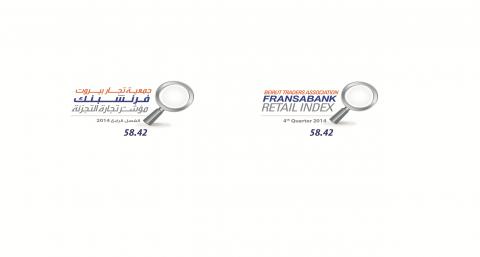Published 10 years ago
Last updated 10 years ago

Despite a twitch at the end of the year,
Markets did not witness any noticeable switch in their activities.
No serious signals anticipating a long awaited recovery were to be detected by the retail trading markets during the last quarter of 2014, bearing in mind that the level of activity in these markets has been subdued relentlessly for almost three long years now. The retail markets did not either benefit from any positive factor that might have underpinned the consumption trend, except the end of year festive season’s drive that was reflected by a twitch in the level of activity during the second half of December. In fact, the markets experienced some revival in the last two weeks of the year, mainly resulting from a relative stability at the security level as compared to the end of year 2013, but also driven by the positive momentum that the multiple bilateral dialogues between the main political parties have started to generate. Yet, and in light of the latest figures related to the fourth quarter of 2014, this “last minute” twitch did not have the necessary amplitude to make up for the losses that were accumulated, not only during the last quarter of the year, but throughout the whole year, nor did it prelude for a revival of consumption and a switch in the trend in theforeseeable future. Getting back to the subjective and negative factors that have continued to undermine the activity of retail trade markets, it is necessary to re-state that these factors do still emanate from a combination of political and security concerns:
Getting back to the subjective and negative factors that have continued to undermine the activity of retail trade markets, it is necessary to re-state that these factors do still emanate from a combination of political and security concerns:
- The political concerns, on one hand, being still instigated by the repetitive scenario of lack of quorum at the parliament to allow for the election of a President, resulting in a dragging vacancy at the head of the state, accompanied by a semi-harmony at the level of the government decision-taking process.
- The security concerns, on the other hand, which continued to be fuelled by the (increasing – yet at a slower pace) settling of Syrian refugees in Lebanon, and what such presence entails in terms of heavy pressures and threats at the social and human points of view, leave alone the persisting tragedy of the military and security soldiers who are still abducted by parties known to everybody, and the lack of apparent progress for their liberation.
|
Yearly Variation between Q4 – 2013 and Q4- 2014 |
|||
|
Q4 - 2014 |
Q4 - 2013 |
||
|
102.11 |
100.00 |
Nominal Year to Year Variation |
|
|
- 0.71% |
CAS Official Inflation Rate between December ’13 and December ’14 (as per the official CAS figures) |
||
|
+ 2.84% |
102.84 |
100.00 |
Real Year to Year Variation |
- The clothing and the footwear sectors, where declines of 19.50% and 34.15% were reported respectively,
- Household items, where sales dropped by 18.75% ,
- Bookstores and Stationery with a 13.50% decline,
- Fast Food and Restaurants which experienced a decline of 9.15%,
- Toys where sales dropped by 9.10%,
- And also electronics, Electrical Equipment and Home Appliances posting figures lower by 5.80%.
- Jewelry and Watches, with an increase of sales of 13.50% as compared to the last quarter of 2013,
- Chocolates and Sweets, where the figures increased by 11.75% (while Supermarkets and Food Shops posted a raise of 2.75% only),
- Perfumes and Cosmetics where real sales value increased by 11.00%,
- Pharmaceutical Products where a 10.15% rise was registered.
58.42 for the fourth quarter of the year 2014.
|
BTA - FRANSABANK Retail Index For Q4 - 2014 (Base 100 : Q4 - 2011) |
|||||||||||||
|
|
2011 |
2012 |
2013 |
2014 |
|||||||||
|
Q4 |
Q1 |
Q2 |
Q3 |
Q4 |
Q1 |
Q2 |
Q3 |
Q4 |
Q1 |
Q2 |
Q3 |
Q4 |
|
| Nominal Index - w/out inflation |
100 |
95.77 |
100.55 |
108.54 |
112.66 |
90.83 |
87.85 |
78.60 |
65.87 |
59.68 |
55.30 |
55.22 |
57.57 |
| Real Index - w/ inflation |
100 |
94.24 |
101.65 |
99.97 |
102.88 |
89.66 |
86.88 |
78.23 |
64.52 |
58.9 |
55.56 |
54.45 |
58.42 |
Categories
- Log in to post comments